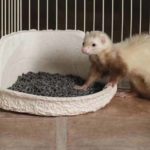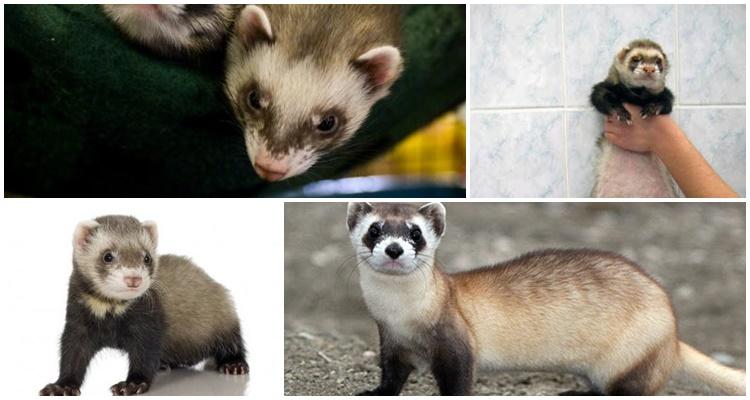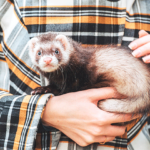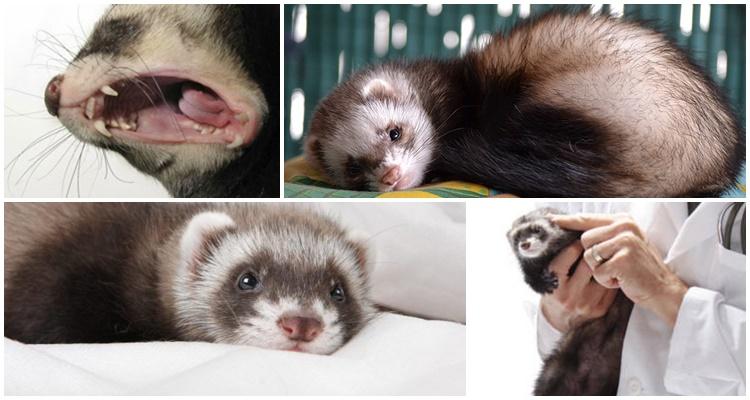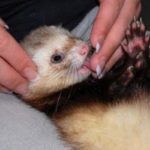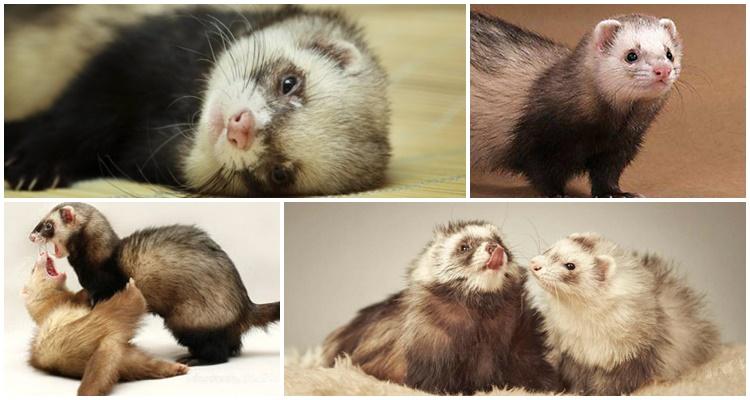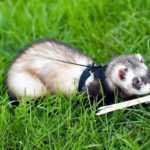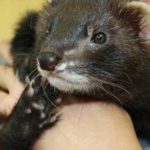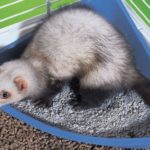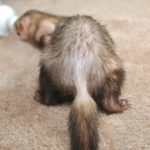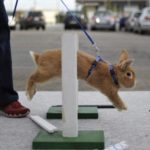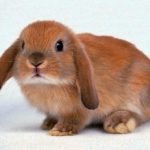Ferret is a decorative ferret, adapted for keeping indoors. The pet is unpretentious, gives a lot of joy and fun, but, like all pets, it needs proper care. Before you become the happy owner of an animal, you need to find out how to care for a domestic ferret, what it eats, and what diseases it is susceptible to. This will prevent troubles, health problems, and premature death of your pet.
- Is it difficult to care for a ferret?
- Advantages and disadvantages
- What breeds of domestic ferrets are there?
- Requirements for the place of detention
- Hygiene
- Ear cleaning
- Nail trimming
- How to bathe a ferret
- What to feed the animal
- Health care
- Walk
- Training
- Coexistence of ferrets with other animals
- Possible problems
Is it difficult to care for a ferret?
Like any pet, a ferret needs care. With proper care, pets live for 10 years, and long-livers can live up to 15 years. Keeping an animal in an apartment is not difficult, care is standard. Main conditions:
- Availability of a secluded place for the ferret to live. The cage should be spacious, dry, warm, and kept clean.
- Comfortable living conditions. There should be no drafts or sudden temperature fluctuations in the room where the ferret is located.
- Organization of walking and training.
- Selection of the right diet, adherence to feeding regimen.
- Constant supervision over the nimble and curious animal so that it does not damage the owner’s property or cause harm to itself.
- Annual visit to the veterinarian for preventive purposes. Vaccination.
Advantages and disadvantages
We love the decorative ferret for its touching appearance and playful behavior. Before getting a pet, you need to evaluate the possibilities of keeping it, consider the pros and cons.
What breeds of domestic ferrets are there?
The ferret is a predator belonging to the mustelidae family. There are 3 wild species: steppe (light), forest (dark), American (black-footed). Ferrets, domesticated representatives of a forest species, have been identified as a separate species. Over many centuries of breeding, ferrets have lost their wild character traits and behavior, and have acquired complaisance, friendliness, and amenability to training.
The domestic species is divided into breeds based on coat color. The natural color of the ferret is dark brown with a light undercoat. The result of selection was the colors:
- white (not to be confused with an albino; the first type has dark eyes, the second has red eyes);
- sable – rich brown color with white undercoat (the most common);
- blaze is a black ferret with white undercoat, a white stripe runs along the head, the chest is decorated with a white spot, there are white “socks” on the paws, the tip of the tail is also white;
- champagne - light chocolate body, dark belly, limbs and tail, white or yellowish undercoat;
- chocolate – rich brown color with a beige undercoat, the muzzle is decorated with a dark mask;
- cinnamon – cinnamon color, beige or milky undercoat, color gradually darkens from head to tail;
- Dalmatian - dark color with light spots on the back, tail, limbs;
- Siamese – dark or light beige color, white or milky undercoat, muzzle decorated with a dark mask.
White animals often have weak immune systems and deafness. Therefore, when purchasing a pet, you should carefully study the veterinary documents.
Ferrets differ not only in color, but also in the structure of their coat.There are types:
- standard with dense undercoat and guard hairs 3 cm;
- Angora – wool 8-12 cm long;
- semi-angora - hairs on the back are 5 cm long, on the belly - 3 cm.
Requirements for the place of detention
Most often, the ferret lives in a cage, which should be spacious and made of safe material. If the cage is only a resting place, and the rest of the time the pet runs freely around the apartment, then its parameters are: 100×100×40 cm. If the ferret spends a lot of time in the cage and actively moves in it, then the height should be 100 cm. The cage should be durable, the gap between the rods is no more than 15 mm. It is advisable to keep several animals in enclosures.
The cage must be equipped with shelves, labyrinths, and toys. It is advisable to hang a hammock in the cage; the ferret will willingly rest in it. Flannelette or woolen fabric is suitable as bedding; you can buy a bed at a pet store. The bedding will have to be changed weekly, as it will absorb the specific smell of the pet.
They must put a house in the cage. The absence of a shelter that imitates a hole is a great stress for the animal. Under such conditions, the ferret dies from nervous exhaustion. The cage house should be spacious so that the ferret can stretch out his legs. The optimal shelter parameters are 50x40x40 cm.
A tray is fixed in the cage, and cat litter granules are used as filler. The cage is cleaned weekly, and the litter in the tray is changed daily.
Hygiene
The ferret must be looked after regularly: bathed, combed, teeth cleaned, claws trimmed. Ferrets love water and are not afraid of swimming.
Ear cleaning
Clean your pet's ears once a month using veterinary ear lotion. They moisten a cotton swab with it, which is used to carefully remove wax deposits from the walls of the ears.The stick should not be inserted deeply, otherwise the organs of the inner ear may be injured.
Nail trimming
The ferret's claws grow quickly. If they are not trimmed, the ferret will cling to curtains, floor carpets, and pieces of furniture with them until a finger or paw is dislocated.
The ferret's claws are trimmed with a nail clipper, being careful not to touch living tissue with blood capillaries. The cut line is made parallel to the curve of the claw.
How to bathe a ferret
Bathe your pet once every six months, using pet shampoo with a low alkali content to prevent hair loss and itching. Shampoo for kittens is suitable, but dog shampoo should not be used for fertilization. Wash the animal under a tap or in a basin filled with 20 cm of water. The water temperature should be approximately 40 °C. When rinsing off the zoo shampoo, be careful not to let water get into your ears. The bathed pet is dried with a towel.
What to feed the animal
A domestic ferret eats either store-bought dry food or natural food. Dry food must be at least premium class. If the pet store doesn't have food for ferrets, it will be suitable for kittens. Fresh water must always be available.
The basis of the fretka’s diet is protein (40%), fats (25%), and vegetable fiber (2%). The ferret should receive enough calcium, phosphorus, magnesium, and vitamins.
What does a domestic ferret eat?:
- lean meat (rabbit, duck, beef, chicken, turkey);
- fish;
- chicken and quail eggs (boiled and raw);
- fermented milk products (but not milk, it causes diarrhea);
- cereal porridges;
- broccoli cabbage.
Health care
The ferret is susceptible to infectious diseases and digestive disorders, so it is important for novice breeders to know how to provide first aid to the animal and what medications should be in the veterinary first aid kit.
Pharmacy kit for ferret includes:
- sorbents (activated carbon) that help with poisoning;
- the drug "Smecta" for diarrhea;
- 5% glucose solution for intoxication;
- antiparasitic and anthelmintic medications;
- antiseptic solutions;
- dressing;
- medical glue for wounds;
- eye drops.
After providing first aid, you cannot treat the animal yourself; you must contact a veterinary clinic. The pet receives its first vaccinations against rabies and distemper at 3 months of age. The veterinarian uses dog vaccines “Novibak” and “Hexadog” (one-third of the standard dose) for ferrets. Further vaccination should be annual. 10 days before ferret vaccinations receives an anthelmintic drug.
Periodically, the animal is given a remedy to remove hairballs from the stomach, and the teeth are brushed with animal paste. If cleaning is difficult, you should contact your veterinarian to remove plaque using an ultrasound machine.
Walk
The ferret loves to walk, and after a walk he feels better. The pet's behavioral characteristics (curiosity, desire to sniff, seek out) do not allow free walking. If the ferret runs away and gets lost, he will die, since he is not adapted to life in the wild.
To prevent the walk from turning into trouble for the ferret, you must follow the following rules:
- accustom the animal to a leash in advance;
- do not let your pet off the leash;
- do not walk an unvaccinated animal;
- do not walk in damp, rainy, windy weather;
- take a walk in a quiet, secluded place.
Training
Ferrets need human attention. Training is not difficult if the ferret trusts the owner. When teaching commands, the animal is interested in a treat, which is given after successfully completing the task. Training is carried out 1-2 hours after the ferret has eaten. You cannot train a hungry or full pet. A ferret is not a good pet if you have a baby in the house. A predatory animal may react aggressively to squeezing and loud noises.
The little ferret is a bully and a mischief-maker, but they begin to train him from the age of 3-4 months. It’s impossible before: the cub is still very small, the owner’s severity will scare him away and make him wild. Parenting requires patience, you cannot shout. They tame the animal by lightly hitting the nose with your fingers and pinching the skin on the withers.
If you do not show the cub who is boss in the family, then in adulthood the ferret will become uncontrollable and wayward.
Coexistence of ferrets with other animals
The fret gets along with its relatives and other pets (cats, non-aggressive dogs), if the owner does not create a situation in which the pets become jealous of him. It is unacceptable to keep them together with hunting dogs and small animals (hamsters, decorative rats), since the ferret has a developed hunting instinct.
Possible problems
Having become the owner of a predatory animal, you need to pay attention to the following nuances:
- There should be no cracks or holes in the house in which the ferret could get stuck.
- You will have to remove pots with plants, electrical cables, medicines, cosmetics, household chemicals, and breakable items from the ferret’s reach.
- The ferret loves to make hiding places, including food caches.Hidden places must be closed, leaving one where it is convenient to remove fret supplies, otherwise the apartment will smell of rotting food.
- You should not allow a curious pet into the kitchen, bathroom, or toilet. In the kitchen, a ferret can throw dishes off the table, dig into flour and sugar, and injure herself with a knife or fork. In the bathroom - swallow washing powder. In the toilet - drown in the toilet.
- Desk drawers, wardrobes, and chests of drawers will have to be locked. The teeth of the small predator are strong enough to chew plastic, knitwear, and rubber.
- In the room where the ferret is located, windows and doors must be closed. An animal can fall from a height, run off for adventure, or become a victim of stray dogs on the street. A mosquito net is not a hindrance; a pet can easily tear it apart with its teeth and claws.
- When the ferret is outside the cage, interior doors should be closed carefully so as not to inadvertently crush him.
- If your home has a fireplace, you should check the chimney before starting a fire. The ferret loves to climb into places that resemble a hole.
Only after ensuring safety in the house can the nimble animal be released from its cage into the wild. Caring for a ferret is not difficult; care and constant monitoring are important.

